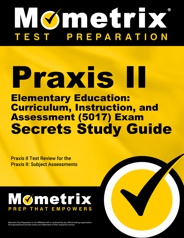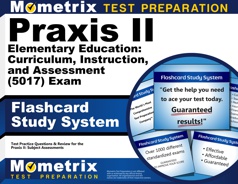The Praxis Elementary Education Curriculum, Instruction, and Assessment exam is designed to measure the knowledge and skills that are essential for teachers of children in elementary schools.
Click “Start Test” above to take a free Praxis Elementary Education Curriculum, Instruction, and Assessment practice test, and check out our premium-quality Praxis test prep resources by clicking the links below!
Exam Outline
The Praxis Elementary Education Curriculum, Instruction, and Assessment exam contains 120 selected-response questions, and you will be given a time limit of 2 hours and 10 minutes.
The exam is split into five content categories, which are designed to cover the various competencies and points of knowledge that a teacher should possess. The questions in each category fall under one of three subcategories: curriculum, instruction, or assessment.
I. Reading and Language Arts (37 questions)
Curriculum
- Sequencing lessons within a curriculum
- Advancing student understanding
- Addressing common student misconceptions
- Making connections within reading and language arts topics
Instruction
- Foundational reading skills
- Reading literature and informational texts
- Writing
- Language
- Speaking and listening
Assessment
- Designing and using formative assessments to adjust instruction
- Designing, using, and interpreting summative assessments
- Recognizing when misconceptions occur
- Selecting and using appropriate assessments to evaluate student learning
II. Mathematics (31 questions)
Curriculum
- Sequencing examples within a lesson to support understanding
- Sequencing lessons within a curriculum
- Addressing common student misconceptions
- Making connections within math topics
Instruction
- Natural numbers
- Whole numbers
- Integers
- Rational numbers
- Proportional relationships
- Number theory
- Expressions, equations, and formulas
- Linear equations and inequalities
- One-, two-, and three-dimensional figures
- Coordinate plane
- Measurements
- Measures of center
- Data
- Probability
Assessment
- Designing and using formative assessments to adjust instruction
- Designing, using, and interpreting summative assessments
- Recognizing when misconceptions occur
- Selecting and using appropriate assessments to evaluate student learning
III. Science (20 questions)
Curriculum
- The purposes of teaching science
- The relationship of concepts within science
- The relationship of science with concepts across other content areas
Instruction
- Science concepts
- Scientific inquiry
- Science processes
- Life science
- Earth and space science
- Physical science
- Health
Assessment
- Designing and using formative assessments to adjust instruction
- Designing, using, and interpreting summative assessments
- Analyzing student work to guide science instruction
- Selecting and using appropriate assessments to evaluate student learning
IV. Social Studies (17 questions)
Curriculum
- The broad purposes of teaching social studies
- The relationship of concepts within social studies
- The relationship of social studies concepts across other content areas
Instruction
- Information-processing skills
- Geography
- History
- Government
- Civics
- Economics
- Anthropology
- Sociology
Assessment
- Designing and using formative assessments to adjust instruction
- Designing, using, and interpreting summative assessments
- Recognizing when misconceptions occur
- Selecting and using appropriate assessments to evaluate student learning
V. Art, Music, and Physical Education (15 questions)
Curriculum
- The fundamental purposes for teaching, physical education, music, and art
- Making connections within and between music, art, and physical education
Instruction
- Developing students’ understanding of art
- Developing students’ understanding of the elements of music
- Music notation and terminology
- Developing students’ understanding of physical education concepts
- Selecting and using manipulatives and developmentally appropriate materials, technology, texts, and equipment
Assessment
- Designing and using formative assessments to adjust instruction
- Designing, using, and interpreting summative assessments
- Selecting and using appropriate assessments to evaluate student learning
Check Out Mometrix's Praxis 5017 Study Guide
Get practice questions, video tutorials, and detailed study lessons
Get Your Study Guide
Registration
To register for the Praxis Elementary Education Curriculum, Instruction, and Assessment exam, you will need to create an online account with ETS. Through this account, you can submit an application to take the exam.
During registration, you will be asked to select the test-taking format (remote or at a testing center), test location (if you are taking the test at a testing center), and test date. You will also need to pay the $130 exam fee.
Test Day
In-person Testing
You should arrive at the testing center 15-30 minutes before the scheduled testing appointment on test day. For the check-in process, you will be asked to provide a printed copy of your admission ticket and two forms of valid identification as soon as you arrive.
You will also be asked to store all personal items (such as your cell phone, wallet, keys, and accessories) in a secure locker before entering the testing area.
Once the check-in process is complete and you are fully approved for testing, you will be led to the testing station and given a brief tutorial on the testing system.
Remote Testing
To take the exam remotely, you must use a laptop or desktop computer that has the ETS Secure Test Browser downloaded and installed on it. This is the browser you must use to take the exam. You will also need a functioning webcam, speakers, and a microphone.
When you check in to take the exam, the remote proctor will ask you to show proof of identification and to move your webcam around the room so that your testing area can be observed. Once the proctor has approved your testing area, they will walk you through the testing process and begin your exam.
How the Exam is Scored
Your Praxis Elementary Education Curriculum, Instruction, and Assessment exam score is based on the number of questions you answer correctly (your raw score). Your raw score is converted to a scaled score. The scaled score you need to obtain to pass the exam is 153.
You should receive an official score report about five weeks after testing.
Check Out Mometrix's Praxis 5017 Flashcards
Get complex subjects broken down into easily understandable concepts
Get Your Flashcards
FAQs
Q
How many questions are on the Praxis 5017 exam?
A
There are 120 selected-response questions on the exam.
Q
How long is the Praxis 5017 exam?
A
The time limit for the exam is 2 hours and 10 minutes.
Q
What is the passing score for the Praxis 5017 exam?
A
To pass the exam, you must achieve a minimum scaled score of 153.
Q
How much does the Praxis 5017 exam cost?
A
The examination fee is $130.
